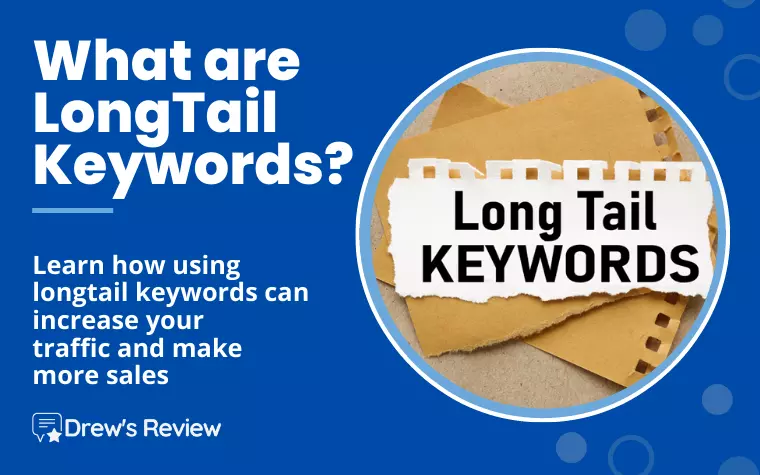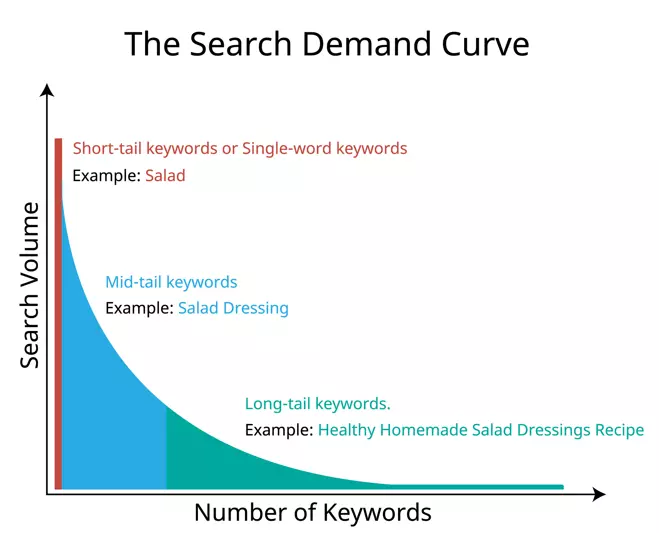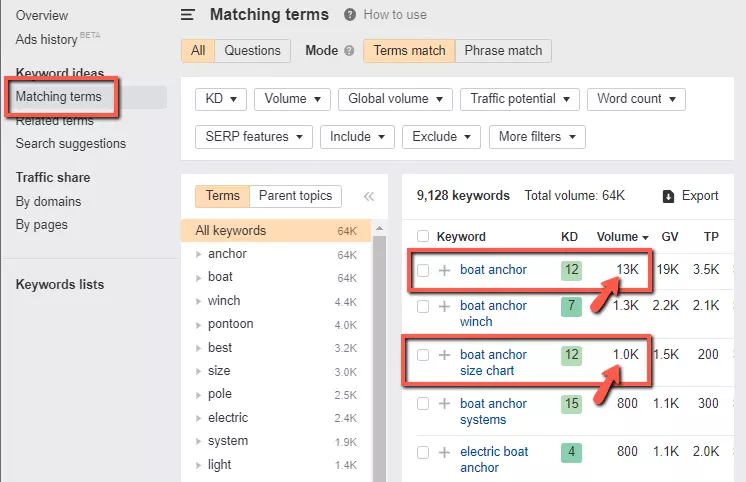
In the SEO world, longtail keywords are a hot topic.
But what are they, exactly? And why should you be using them in your content and marketing strategy?
In this blog post, I will answer all of those questions and more! I'll explain what longtail keywords are, how to find them, and how to use them to get the most out of your SEO efforts. So read on for all the details!
What are LongTail Keywords?
Longtail keywords are simply keywords that are more specific than the average keyword. Long tail keywords are search phrases with longer word counts. For example, instead of just "shoes", a longtail keyword might be "women's size 8 black running shoes".
While they may get less traffic than general keywords, longtail keywords can be a great way to target niche audiences and get more qualified leads. That's because people who use longtail keywords are usually further along in their buyer's journey and have a higher purchase intent.
In other words, if someone is searching for "women's size 8 black running shoes", they're probably ready to buy! And that's exactly the kind of customer you want, right?
That's why part of your marketing strategy should include a focus on long tail keywords. This should answer the question - Are long tail keywords important for SEO? You betcha! 😉
LongTail Keyword Examples
Some other examples of long-tail keywords are:
As you can see, these keywords are much more specific than just "shoes or pumpkin carving". These are what are referred to as head keywords that are more broad, general, and harder to rank for. Longtail keywords are easier to rank for and that's what makes them so valuable.
It should be part of everyone's SEO strategy.
Why Are Longtail Searches Valuable?
When people search for something online, they usually start with a general keyword or phrase.
For example, if they're looking for information on the best way to reduce stress, they might search for "stress relief." However, this type of broad search can produce a lot of results with very high search volume that aren't necessarily relevant to what the person is looking for. This is where long-tail searches come in.
A long tail search is a more specific search query that is less likely to be used by other people. For example, rather than searching for "stress relief," someone might use a long-tail search like "ways to reduce stress for working mothers."
Long-tail searches are valuable because they tend to be more specific, higher qualified search traffic, and therefore more likely to produce relevant results.
In addition, they can also help you to target a specific audience with your content. For example, if you know that your target audience is working mothers, you can use long-tail searches to make sure that your content comes up when they're looking for information on reducing stress.
Here is the search demand curve using the keyword "salad dressing". Note how the long tail variation is used. You can see search volume drops the more specific the term is. However, as explained, this is not a bad thing. It's because it's much more targeted.

How to Find Long Tail Keywords?
Now that we've answered the question "what are long-tail keywords," it's time to move on to the next question: how do you find them?
The best way to find long-tail keywords is to use a keyword research tool. There are a number of different keyword research tools available, but a lot of them are paid. Some of the paid ones are "Longtail Pro" and "Ahrefs". Both of these will give you a ton of longtail keyword suggestions.
Here is an example on how to find longtail keywords using ahrefs. I typed in the keyword "boat anchor" in the keywords explorer section. When you click on "matching terms" you will get a list. This is a very small sample size but you can see that you'll get variations of the main keyword that are longtail.
You can see how "boat anchor" has a search volume of 13K, while "boat anchor size chart" (which is a longtail version of boat anchor) only has 1K searches.
You can also see how "electric boat anchor" has even less, but the Keyword Difficulty to rank is less.

You can use free tools to find longtail keywords. My favorite is the Google Keyword Planner. This tool is free to use and can be accessed by anyone with a Google account.
To use Google Keyword Planner, simply enter a general keyword or phrase into the search bar. For example, if you're looking for long-tail keywords related to stress relief, you might enter "stress relief" into the search bar. Once you hit enter, you'll see a list of related keywords.
To find long-tail keywords, simply scroll down the list and look for keywords that are specific and relevant to your topic. In our example, some of the long-tail keywords we might find are "ways to reduce stress for working mothers," "natural stress relief methods," and "stress relief tips for busy moms."
I also really like Keywords Everywhere. It's very cheap and "practically" free. I think I spent no more than $10 using this tool last year. You get a ton of searches on the cheap.
Here's an example using Keywords Everywhere. I typed in the search term Golf Clubs. This is what came up:

If you have a golf site, just look at all the longtail keywords you can write articles on and rank for.
You can also find longtail keywords at the bottom of Google in the "related searches" section. These are pretty limited, but you can get an idea on the most popular terms related to the main one.
Here are some more tips:
Look at your existing content: Another great way to come up with ideas for long-tail keywords is to look at your existing content. See what topics you've already covered and look for ways to narrow down those topics even further.
Think like your customer: When you're trying to come up with ideas for long-tail keywords, it's important to think like your customer. What would they be searching for if they were looking for your product or service?
Ask your customers/readers: One of the best ways to come up with ideas for long-tail keywords is to simply ask your customers. See what terms they use when talking about your business, and use those as potential keywords.
Generally, longtail keywords are longer than 3 words. That's how you can identify them.
Once you've found a few potential long tail keywords, it's time to test them out!
How to Rank for Longtail Keywords?
Just like with any other keyword, you need to put in the work if you want to rank for long-tail keywords. Here are some tips on how to do that:
Create high-quality content: This is always the first step. You can't rank for a keyword if you don't have content that's relevant to it. So, before you even start thinking about ranking for a particular keyword, make sure you have great content that's relevant to it and include long tail keyword phrases.
Do your research: Before you start creating content, it's important to do your research and understand what people are actually searching for. That way, you can create content that's tailored to their needs and more likely to rank well.
Optimize your title and meta data: Once you have your content, it's important to make sure that it's optimized for the keyword you're targeting. That means including the keyword in your title and making sure that your metadata is accurate and relevant.
Promote your content: Just creating great content isn't enough. You also need to promote it if you want people to see it. There are a number of ways to do this, but some of the most effective include social media, email marketing, and guest blogging.
Monitor your progress: Finally, once you've done all of the above, it's important to monitor your progress and see how well you're ranking for the keyword. This will give you an idea of what's working and what's not, and allow you to adjust your strategy accordingly.
The Two Types of Long-Tail Keywords
No long tail keyword is the same. Some represent unique search queries and others are simply lesser-known variations.
The former are called topical longtail keywords, while the last is referred to in terms of longtail keywords. The main difference between the two is that topical keywords are more specific while longtail keywords are simply longer versions of popular search terms.
Examples of Topical Long-Tail Keywords:
Longtail Keywords: These are simply longer versions of popular keywords. They're not as specific as topical keywords, but they can still be useful in getting your content seen by more people.
Examples:
See the difference?
Why Long-Tail Keywords Are Key to Boosting Traffic and Conversions?
This is because you are targeting exactly what the customer is looking for. The more closely related your article or page is to the initial query, the more likely you will have success in the search engines. This is because you are closely matching the intent, which is a major ranking factor for Google.
Another reason long-tail keywords are key is because of the low competition. When you target a more specific keyword, there will be less competition from other pages going after the same phrase. This gives your page a better chance to rank in the search engines, which can lead to more traffic and conversions.
So, if you're looking to boost traffic and conversions with your SEO efforts, focus on targeting long-tail keywords. They may take a little more work to find and generally have less traffic, but they're worth it in the end.
What Makes Longtail Keywords So Great?
There are a few things that make longtail keywords so great.
First, they are more specific than general keywords. This means that you're more likely to get traffic from people who are actually looking for what you have to offer.
There is less competition for longtail keywords. This means that it's easier to rank in the search engines for these keywords, which can lead to more traffic and conversions.
Finally, longtail keywords tend to have a higher conversion rate than general keywords. This is because people who use longtail keywords are usually further along in the buying cycle and are therefore more likely to convert into customers or clients. This means you'll make more money!
Benefits of Long-tail Keywords for SEO
There are many benefits of using longtail keywords for SEO. Here are a few of the most important ones:
Conclusion
So there you have it. Longtail keywords are a great way to improve your SEO and get more traffic and conversions. These specific, relevant keywords are easier to rank for and tend to have a higher conversion rate. If you're looking to improve your SEO, focus on targeting longtail keywords. Just do it!
Do you have any tips on how to use longtail keywords? Let me know in the comments below!
Found this useful? Please share!
- Best Ways to Make Passive Income on YouTube - April 15, 2024
- How I Make Faceless YouTube Channels With AI - April 9, 2024
- Top 21 Faceless YouTube Niches to Earn Big Profits in 2024 - April 3, 2024

How many times and in which specific places besides the title should you place your long-tail keywords ?
There is no rule of thumb here. As long as they are used at least once in the article that’s fine. Just don’t overdo it. The key is to ensure the article reads natural.